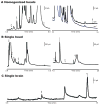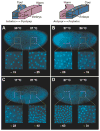Chemical measurements in Drosophila
- PMID: 20161412
- PMCID: PMC2786087
- DOI: 10.1016/j.trac.2009.08.005
Chemical measurements in Drosophila
Abstract
The fruit fly, Drosophila melanogaster, has been extensively used as a model organism in genetics research and has significantly contributed to understanding molecular, cellular and evolutionary aspects of human behavior. Recently, research has focused on developing analytical methods to obtain highly sensitive chemical quantification along with spatiotemporal information from Drosophila melanogaster. We review a number of these advances in capillary electrophoresis, high-performance liquid chromatography, mass spectrometry and technologies involving intact organisms, including in vivo electrochemistry.
Figures






Similar articles
-
Micellar capillary electrophoresis--electrochemical detection of neurochemicals from Drosophila.J Sep Sci. 2010 Feb;33(3):388-93. doi: 10.1002/jssc.200900634. J Sep Sci. 2010. PMID: 20063357
-
Fly-on-a-Chip: Microfluidics for Drosophila melanogaster Studies.Integr Biol (Camb). 2019 Dec 31;11(12):425-443. doi: 10.1093/intbio/zyz037. Integr Biol (Camb). 2019. PMID: 31965192 Review.
-
Drosophila as a Model System for Neurotransmitter Measurements.ACS Chem Neurosci. 2018 Aug 15;9(8):1872-1883. doi: 10.1021/acschemneuro.7b00456. Epub 2018 Feb 20. ACS Chem Neurosci. 2018. PMID: 29411967 Free PMC article. Review.
-
[Advances in chiral separation and analysis by capillary electrophoresis-mass spectrometry].Se Pu. 2022 Jun;40(6):509-519. doi: 10.3724/SP.J.1123.2021.11006. Se Pu. 2022. PMID: 35616196 Free PMC article. Review. Chinese.
-
Translational Metabolomics of Head Injury: Exploring Dysfunctional Cerebral Metabolism with Ex Vivo NMR Spectroscopy-Based Metabolite Quantification.In: Kobeissy FH, editor. Brain Neurotrauma: Molecular, Neuropsychological, and Rehabilitation Aspects. Boca Raton (FL): CRC Press/Taylor & Francis; 2015. Chapter 25. In: Kobeissy FH, editor. Brain Neurotrauma: Molecular, Neuropsychological, and Rehabilitation Aspects. Boca Raton (FL): CRC Press/Taylor & Francis; 2015. Chapter 25. PMID: 26269925 Free Books & Documents. Review.
Cited by
-
Oral administration of methylphenidate blocks the effect of cocaine on uptake at the Drosophila dopamine transporter.ACS Chem Neurosci. 2013 Apr 17;4(4):566-74. doi: 10.1021/cn3002009. Epub 2013 Feb 25. ACS Chem Neurosci. 2013. PMID: 23402315 Free PMC article.
-
Anti-obesity effects of Erythrina abyssinica stem bark extract in flies exposed to a high fat diet.Heliyon. 2022 Jul 6;8(7):e09886. doi: 10.1016/j.heliyon.2022.e09886. eCollection 2022 Jul. Heliyon. 2022. PMID: 35847607 Free PMC article.
-
Using In Vivo Electrochemistry to Study the Physiological Effects of Cocaine and Other Stimulants on the Drosophila melanogaster Dopamine Transporter.ACS Chem Neurosci. 2010 Jan 20;1(1):74-83. doi: 10.1021/cn900017w. ACS Chem Neurosci. 2010. PMID: 20352129 Free PMC article.
-
Neuronal identity control at the resolution of a single transcription factor isoform.bioRxiv [Preprint]. 2024 Jun 14:2024.06.14.598883. doi: 10.1101/2024.06.14.598883. bioRxiv. 2024. PMID: 38915533 Free PMC article. Preprint.
References
Grants and funding
LinkOut - more resources
Full Text Sources
Molecular Biology Databases
